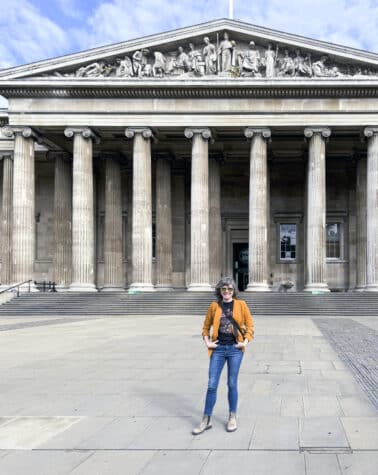IAIA Museum Studies Department Chair Participates in British Museum’s International Training Programme
Mattie Reynolds (Choctaw National of Oklahoma) spent six weeks in London this past summer as a fellow in the British Museum’s International Training Programme (ITP). Reynolds, an assistant professor and chair of the Institute of American Indian Arts (IAIA) Museum Studies program, was one of only 20 museum professionals selected from across the globe for the highly competitive program. She was the only professor or university employee in the group and—she believes—only the second Native American to participate in the ITP.
Reynolds learned about the ITP from Rose Taylor, the British Museum’s curator for the Americas. The pair met last summer at a Native art symposium held at The Courtauld Institute of Art in London. IAIA colleagues Dr. Kay Holmes (Mvskoke [Creek] descendant), chair of Liberal Indigenous Studies, and Daisy Quezada Ureña (Mexican-American), chair of Studio Arts, also attended the conference. Once back in Santa Fe, Reynolds said she kept in touch with Taylor, “in the hopes of inviting her to guest lecture in some of the museum studies’ programs.”
Reynolds added that Taylor is “very interested in expanding the contemporary Native art collection at the [British Museum] and suggested that we would work well together in that respect. She also wanted input about the plans for reimagining the North American Gallery, where the Native American collection is exhibited.”
A wide variety of topics were covered in the ITP—everything from textile conservation to repatriation and restitution. “The intent is for ITP fellows to come away with a broad understanding of how the British Museum operates as an institution—what they consider best practices, and to compare that to smaller UK institutions with our partner placements,” Reynolds said. “Then we use what we learn to our advantage in our institutions, along with sharing our opinions of best practices from our countries.”
As part of the program, ITP fellows work with other museums in the UK. Reynolds and three others spent 10 days partnering with the Manchester Art Gallery, Manchester Museum, and Whitworth Art Gallery in Manchester, UK, which is about four hours from London. “Manchester Museum and Whitworth Art Gallery are part of the University of Manchester, which has undergrad, grad, and doctorate museum studies programs, which is why I wanted to be placed there,” Reynolds said.
“I wanted to be able to compare how university museums help to nurture emerging museum professionals in their schools, how active they are with faculty support and research, and how committed they are to being resources for student success. We were able to talk with a wide range of staff members from each museum about the work that they do.”
Reynolds said a high point of her time in Manchester was meeting Dr. Alexandra Alberda (Jemez Pueblo), who was recently hired by the Manchester Museum as curator of indigenous perspectives. “[It’s] the first position of its kind in the UK,” Reynolds said. “We were able to spend an afternoon with her, talking about her work.”
Reynolds, who teaches classes at IAIA on Indigneous repatriation, appreciated the staff at the British Museum for their willingness to field tough questions, saying she “repeatedly asked about repatriation and restitution and efforts to change the laws that govern those things in the UK.” She also enjoyed learning about the museum’s “efforts towards collaborative, community-based research projects on an international level.”
During their time in the UK, the ITP fellows also visited other museums and heritage sites. “[They] arranged for a ton of field trips, like Stonehenge,” Reynolds said. “However, my favorite was a day trip to Oxford, where we were able to visit the Ashmolean Museum and Pitt Rivers Museum, which have been on my bucket list since graduate school.”
Working, learning, and networking with museum professionals from all over the world also was a highlight for Reynolds. In addition to the US, fellows hailed from Brazil, China, Colombia, Cyprus, Egypt, Ghana, India, Kenya, Myanmar, Oman, and Turkey.
“I’ve learned an incredible amount from the participants sharing about their work, not just in structured sessions but in informal ways, like sharing a meal or walking around various museums together—from language and cultural traditions to struggles of funding and preservation of cultural heritage that resound, no matter where we’re from,” Reynolds said.
“One really special story is that my birthday was about a week into the start of the program. The other fellows sang me ‘Happy Birthday’—in English, then Swahili, then Arabic. It was incredibly special.”
Now, back in the States, Reynolds is anxious to share what she’s learned and put her networking to good use. “I have several new connections that I hope will develop into internship opportunities for students,” she said, adding that ITP experience also will influence “how I approach interpretation and education in my curation class. This program has made me look at working with communities in an entirely different way. I’m also planning to integrate what I learned about various approaches to repatriation, based on UK law, into my repatriation classes.”
“We are proud of our faculties’ personal and professional commitment to fulfilling IAIA’s engagement initiative of “elevating Indigenous arts and cultures globally”. For over 60 years, IAIA has committed itself to the advancement of contemporary Indigenous arts and cultures, and we are excited by the prospect of expanding our commitment to an eager global audience. We look forward to building on Professor Reynolds’ work to grow our curriculum, build collaborative and reciprocal relationships with international organizations, institutions, and artists, and to prepare our students to be leaders in championing understanding and appreciation for Indigenous arts, cultures, and values,” said IAIA Provost Colón.
